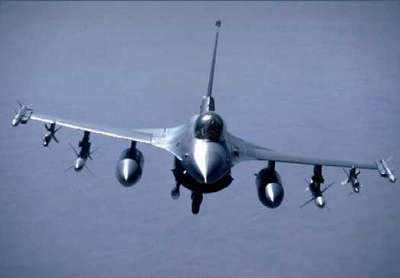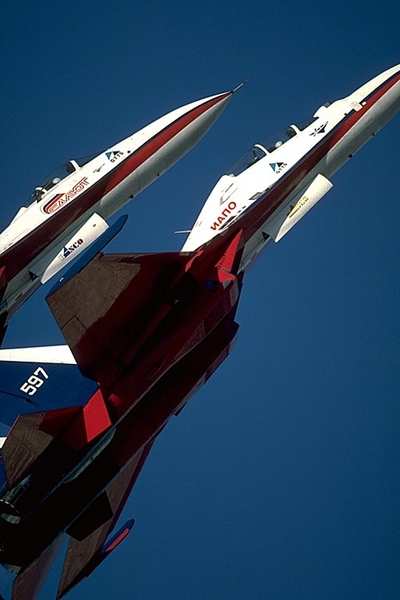Report: It's A $7 Billion Market Outside NATO
The next ten years will see continued growth in purchases of new
fighter aircraft. Outside North America and Western Europe, this
will especially be the case in Asia where up to $7 billion may be
spent on new fighter programs. In Eastern Europe and Latin America,
several countries will be making important strategic decisions
about the future of their air defence capability in the near
future. It is therefore essential that the companies involved are
aware of these opportunities in order to offer the best possible
conditions to potential buyers.

India expects to experience sustained economic growth in the
next decade and wants to ensure that no threats to the
subcontinents security will endanger this growth. In line with
that, there will be large-scale purchases in order to boost
capability and replace old equipment.
Approximately $3 billion have already been spent on 140 new
Su-30s that will be delivered between 2007 and 2017. "Up to 130
medium sized fighter aircraft are also needed, and a notable shift
was made when it was announced that F-16 is considered as a strong
contender. Also, more new training, special mission aircraft and
helicopters are needed for all three services. All these purchases
will be followed by additional related contracts for MRO and
Training and Simulation worth hundreds of millions of dollars,"
according to Marko Lukovic, Research Analyst at Frost &
Sullivan.
China is much more of a mystery, as the nation's defence
procurement system is still completely opaque. It is known that
they have been heavily modernising their Armed Forces over the past
decade, but it is not certain what kind of a mix of modernised
domestically produced and imported equipment the Chinese have
managed to acquire. It is known that the purchases of Su-27s have
stopped after about 120 were built. "However, it is unclear whether
this had happened because they wanted to build them with better
avionics after the EU sanctions are lifted as expected, or because
the indigenous J-10 fighter is considered to be a better value
product," Lukovic added.
Chinese Defence industry is eagerly awaiting the final decision
regarding the lifting of EU sanctions and will continue the
procurement drive only after the necessary adjustments have been
made to include new technologies they expect to buy, should the
sanctions be lifted.

In Eastern Europe, the countries currently in focus are Bulgaria
and Romania. Both of these countries have been looking to buy
western aircraft for over ten years in anticipation of joining
NATO, but there were other more pressing priorities. Now that both
countries are full NATO members, it seems fighter aircraft
procurement is finally due. Judging by their spending to date,
Romania is likely to purchase up to 50 second hand F-16s Block 15
or similar, which will then incrementally modernised as funds are
made available, probably with Israeli assistance. The Bulgarian
procurement decision is still very much open to speculation, but it
is hoped that their plans will be announced soon.
In Latin America, most countries have cash-strapped Air Forces
that need replacement of a large portion of their inventory but
cannot afford it. There are, however, a few notable exceptions such
as Chile and Colombia. Chile has placed an order for 10 Block 52
F-16 and will be negotiating a second batch later this year, while
the Colombian government has just announced that it has set aside
$540 million for a purchase of 22 new combat aircraft to be used
against the guerrillas and drug producers.
Although it is the most powerful country in the region and the
largest economy, Brazil has cancelled the troubled F-X fighter
project. As most of Brazilian Air Force inventory has passed or is
very near the end of service life, it is to be expected that 20-30
combat aircraft will be ordered in the next 5 years. Otherwise, the
current airworthy fleet will find it increasingly difficult to
control airspace over the Amazon and prevent narcotics
transports.

"From the few example listed above, it is clear that the
procurement of fighter aircraft will continue steadily in the next
decade in countries outside North America and Western Europe," Mr
Lukovic states. There is a clear market shift towards the emerging
regional and global powers such as China, India, Brazil and South
Africa that want to go beyond pure self-defence and project that
power.
Mr Lukovic further observers a notable shift in procurement
methodology, especially in India and Brazil, where the emphasis on
quality and value for money has gained in prominence, and
procurement decisions are no longer based purely on political
reasoning.
"It should also be noted that procurement of fighter aircraft in
countries mentioned above is relatively undeterred by the emergence
of Unmanned Combat Airborne Vehicles (UCAVs), although some of them
have long-running UAV programmes." Despite the fact that the global
defence requirements have changed beyond recognition in the past 20
years, the multirole capability has ensured that there will be a
requirement for manned combat aircraft for at least another two
decades.
 ANN's Daily Aero-Linx (04.15.24)
ANN's Daily Aero-Linx (04.15.24) Classic Aero-TV: 'No Other Options' -- The Israeli Air Force's Danny Shapira
Classic Aero-TV: 'No Other Options' -- The Israeli Air Force's Danny Shapira Aero-News: Quote of the Day (04.15.24)
Aero-News: Quote of the Day (04.15.24) Airborne 04.16.24: RV Update, Affordable Flying Expo, Diamond Lil
Airborne 04.16.24: RV Update, Affordable Flying Expo, Diamond Lil ANN's Daily Aero-Term (04.16.24): Chart Supplement US
ANN's Daily Aero-Term (04.16.24): Chart Supplement US





